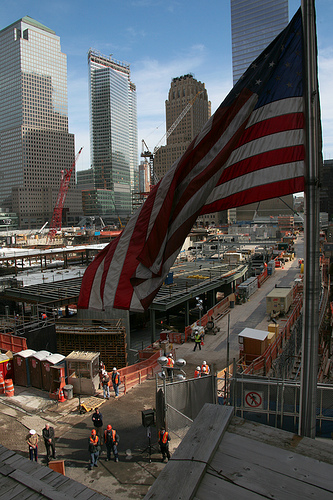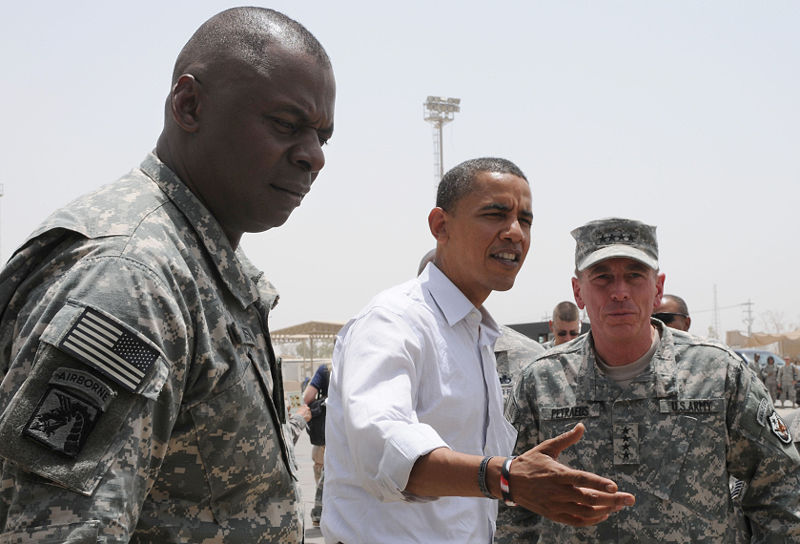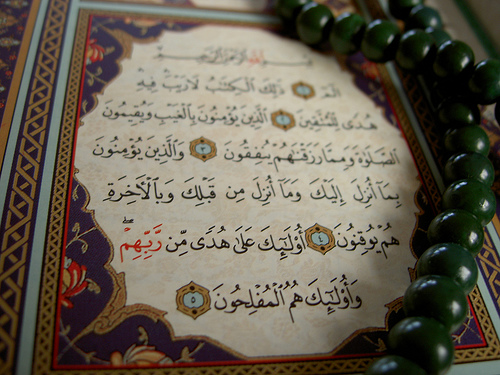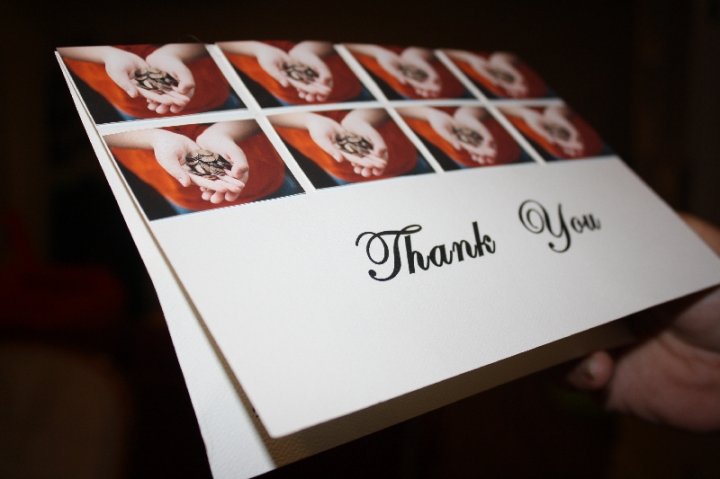
A US flag flies at the Ground Zero construction site. <a href="http://www.flickr.com/photos/nycmarines/3567364932/">US Marine Corps photo by Sgt. Steve Cushman</a>/Creative Commons
[This article first appeared in Current Intelligence Magazine on September 9, 2010, and is republished here courtesy of its editors.]
Every cloud-piercing building in Manhattan is a holy church of one sort or another. Regardless of its function or of the liturgy presented within, each structure has always stood as an advertisement for pluralism, America’s One True Religion. This is New York City, won by Dutch explorers from its natives not in battle but in a transaction, while in Europe, caissons and kingly heads still rolled in brutal wars of empire, succession, and faith. This is a city acquired by the English, converted into “American,” and then settled by speakers of every tongue on Earth. In such close contact, the émigrés compete, and there are occasional struggles, riots, street crimes. But the competition is just that: a game, rather than a war. A great faith was built upon such games.
Since 1971, one church with its twin spires stood at the center of this faith. From one of its columns—the Top of the World, the observation deck on Floor 107 of the World Trade Center’s South Tower—one could view the One True Religion’s other great temples: Ellis Island, where some of my ancestors, the Donigers and the Weinsteins, cemented their conversion; Manhattan’s Lower East Side, where they lived among the other immigrant poor; the Statue of Liberty, that most supreme of pilgrim shrines.
On September 11th, 2001, I had planned a Manhattan pilgrimage of my own. It was Tuesday of the second week in my senior year at Columbia, and I’d intended to wake at a dark hour and ride the No. 1 train down to the first stop in Brooklyn. Once there, repeating a path I’d trod in earlier years, I’d walk the Brooklyn Bridge, pausing in the middle of its boardwalk to face south and take in the sunrise over New York Harbor: to the left, the Verrazano Narrows Bridge and the Atlantic beyond its span; to the right, Lady Liberty. If I’d timed the trip right, they’d be connected—asphalt, ocean, and bronze, an American trinity—by a ribbon of sunshine. It would breach the horizon, then climb ’til its light and its heat reached the spot on the bridge where I was standing. Satisfied that east was still east, and the sun was where it should be—over this place—I’d descend into Manhattan, to the World Trade Center, down to the massive bookstore in its sub-level shopping promenade, there to continue my real education.
Things didn’t turn out the way I’d planned on that day. I awoke late and alone in a dorm room, the sun already flashing through the window. Stepping into the hall, I noticed a crowd gathering at the hall’s far end, leaning out of its south-facing window. I approached, and I saw the smoke.
It was the beginning of a very long day. Against my parents’ advice—it had taken an hour to get through on a cell phone—I took a cab to Union Square. From there, I walked to an elderly friend’s office to check on her. I wanted to give blood on the way, but there was already a line of NYU students and professors snaking four blocks around Beth Israel Medical Center. Upon finding my friend and sharing a good cry, we made our way on foot up Park Avenue to Grand Central Station. Rumor had it trains were still running out of the city from there. Everyone walked. Public transport had come to a standstill, and taxis were price gouging. Yet business owners, doormen, and church elders lined the sidewalk, offering the trekkers free food, drink, and a place to rest. It was the greatest act of collective sincerity and kindness I have ever witnessed.
IT IS FASHIONABLE to call what happened that day an “attack on America.” That’s what it was, strictly speaking. As I stood near Broadway and 18th Street that afternoon, watching the towers’ ash clouds rise on the harbor wind and blow out to Brooklyn, Chic Burlingame, a retired Navy officer and fighter pilot, passed the final moments of his life herded to the rear of a hijacked American Airlines jet that would strike the outer ring of the Pentagon. He had been the captain of that American Airlines flight. The Pentagon, in a sadly ironic twist, had been Chic’s last duty station before his retirement from the Naval Reserve. He was also a friend; he had recruited me into the Navy, and mentored me during my brief military career. Chic, his passengers, and the Trade Center victims were joined in death by the occupants of a United Airlines flight that, a short while later, smashed into the ground outside Shanksville, Pennsylvania. In cities all across the nation, families and friends experienced very real losses—and in the sudden, bold violence of the act, they wondered what or who else could be lost.
It was an “attack on America.” And the site where the Twin Towers stood is “hallowed ground.” And yet. The people today who are likeliest to employ those phrases are also the least likely to appreciate the American faith that the towers and their city embodied. On the lower end of the intellectual spectrum, these critics are the insular drones of militant Americanism, people who think New York’s melting-pot mentality is an enabler of evil, rather than a desirable social end. They fail (or refuse) to recognize that Lower Manhattan was hallowed long before 9/11, by the African slaves (at least some of them Muslim) buried in its earth; by the New York Dolls strip club on West Broadway, and the flophouse motels and Buffalo-wing saloons that flank it; by the homeless huddling in the Park Place and WTC subway stations; by the sheer diversity of humanity that had long lived, worked, and died in this place.
But those drones have their priests at the high end of the spectrum, neoconservative intellectuals and political tastemakers engaged in their own cynical games of conquest. When the towers fell, those priests and their ministry emerged as if from nowhere. In that moment when our great temple was lost and so many parishioners were interred in its rubble, when we needed our faith the most, it was shaken. We needed to know the significance of it all, the reason for it. We needed to know it would be all right, that justice would be done.
In that moment, we could have redoubled our faith in the America that is New York. We could have affirmed the sentiment offered us by 60,000 solemn Iranians (Iranians!) observing a minute of silence in Tehran’s largest soccer stadium—a sentiment epitomized in Le Monde‘s September 12 front-page headline: “Nous sommes tous Américains.” We could have ushered in a new era of cosmopolitanism, not only abroad, but on United States territory, from Guam to the newly-christened Ground Zero.
We could have. But we didn’t. We needed war—for, as journalist Chris Hedges wrote, war is a force that gives us meaning. And it continues to, not just abroad, but at Ground Zero.
OF COURSE, some war seemed reasonable in 2001. I rejoined the military hoping to serve in Operation Enduring Freedom, the campaign to defeat the Salafist Islamic militants of Al Qaeda and their Afghan state sponsors, the Taliban. I left the service shortly after, the hunt for Al Qaeda bogged down in open-ended occupation and its architects, rather than pressing for a comprehensive Afghan victory, shifted their focus to Iraq. This reflected the neoconservative pathos among the George W. Bush administration and its supporters, something contrary to the cosmopolitan, pluralist faith seen in New York. Intellectuals, civil servants, and journalists—names like Kristol, Cheney, Rumsfeld, Wolfowitz, Krauthammer, Gerecht—led the way. Theirs was an interventionist, exceptionalist US foreign policy that stood in contrast to neoliberalism; simpler, less pluralist, more muscular. In this worldview, “America” was a singular beacon of right, and all who resisted it in any way were monolithically wrong. As a mythos for explaining the American people and their tribulations, it was attractive all the more for its inelegance. As a foreign policy, it was a disaster.
That the neocon tendency could have dominated the past eight years of foreign policy discourse in America is no surprise. It dovetailed nicely with post-9/11 domestic discourse in American locales far removed from New York City, places protected by their provinciality and their homogeneity. This is Inner America: not just a physical place, but a mental one, too, metastasized to every corner of the nation. It is the id of a state, unrestrained by a superego. Its hallmarks are American exceptionalism, xenophobia, muscular Judeo-Christianity, and the privileging of emotional arguments over intellectual ones. It believes that diversity and dissent—the very broad bases of the nation’s civic faith before 9/11—invite national weakness and ruin.
To the neocon priests and their flock in Inner America, one group has always been more monolithically wrong than all others: the world’s Muslims. It’s been said that a conservative is a liberal who has been mugged by reality. Neoconservatives and Inner Americans, then, must be liberals who have been mugged by reality, and blame it on Islam. Before North Korea, before China, neocons and Inner Americans perceived their greatest enemies to be in the Middle East and South Asia, and they prescribed military intervention accordingly. In doing so, they had to perform the most incredible of mental gymnastics, conflating the Salafist Al Qaeda threat with the Shi’ite revolutionary government in Iran and, of course, the nationalist dictatorship of Saddam Hussein in Iraq. In the event, neoconservatism brought us no justice or closure in Afghanistan. It brought us woe in Iraq, it deepened our nation’s financial ruin, and it cemented our global reputation as profilers and torturers of minorities. In short, it proved itself a spectacular failure; Barack Obama, a centrist Democrat who advocated a liberal, multilateral foreign policy and an eventual end to America’s expeditionary wars, was to be its antidote.
Despite all of that, Inner America is resurgent, and so are its priests. Two years of the Obama presidency have proven insufficient to restore America’s prosperity and prestige. In fact, to Inner America, this administration and its supporters represent a further assault on their Manichaean worldview, an advance of the very diversity and dialogue they believe dilute their “American” values. The president is, after all, a multiracial man with a funny name, tied by his detractors to the Islamic world. He is a deceiver and a usurper to them. His rise to power, rather than ushering in a post-racial era in the United States, has emboldened Inner America to declare openly its antagonism to all that is different, alien, potentially subversive.
THE CURRENT OBJECT OF THIS IRE is a new structure planned on Park Place, two blocks from where the northernmost of the Twin Towers stood. This is Park51, a Muslim-oriented community center also known as the Cordoba House or the “Ground Zero Mosque.” It’s a space meant to propagate the same faith the Towers represented: not Islam, but rather, pluralism. In the end, it will be the only sort of sacred space Manhattan really knows, an upward-stretching column of steel and glass, a windbreak and a place of communion for the city’s densely packed multitudes.
Spearheading the Park51 plan is 62-year-old Feisal Abdul Rauf, a Columbia-educated Sufi Muslim who has lived in New York since the 1960s and has led a mosque in the city for 27 years. Rauf is something of a jet-setter, a frequenter of panels at the World Economic Forum and the Aspen Institute. He seems to aspire to de facto leadership in the American Muslim community, becoming a best-selling author and Islamic mega-church patrician in the mold of Christian pastors like Rick Warren and Joel Osteen. By building flocks around child daycare, Starbucks coffee, and arena big-screen TVs, those pastors have fused economic success—the universal standard of American achievement—with soul saving and mainstream acceptance of their convictions. Rauf clearly hopes his Lower Manhattan center, replete with basketball court, auditorium, and yes, a mosque, will earn him the same acclaim. In that way, the Arab-born Muslim could not be more loyal to American values.
That’s not the way Inner America sees it. Early last May, in the midst of a contentious national midterm election campaign, a bombastic right-wing blogger named Pamela Geller wrote a blog post titled “Monster Mosque Pushes Ahead in Shadow of World Trade Center Islamic Death and Destruction.” In it, she described Park51 as “Islamic domination and expansionism. The location is no accident. Just as Al-Aqsa was built on top of the Temple in Jerusalem.” As Salon has pointed out, Geller has also claimed that Obama is literally the child of former Nation of Islam minister and American dissident Malcolm X. After beating the battle drums for several more months, Inner America’s lay clergy began to take note: vice presidential also-ran Sarah Palin, philandering former congressional speaker Newt Gingrich, and ex-New York mayor Rudy Giuliani had all joined a chorus condemning the “Ground Zero Mosque” and demanding that it be located elsewhere.
Ground Zero Mosque opponents include Debra Burlingame, my old friend Chic’s sister. When he died, she founded a group called “9/11 Families for a Safe & Strong America,” which endorsed the Iraq war and Bush’s reelection in 2004. She also joined forces with Liz Cheney, the former vice president’s daughter, and neocon William Kristol to form “Keep America Safe,” a right-wing lobby group that “believes the United States can only defeat our adversaries and defend our interests from a position of strength.” According to Debra, a former New York-based CourtTV producer, Imam Rauf is one such adversary:
9/11 was more than a “deeply traumatic event,” it was an act of war. Building a 15-story mosque at Ground Zero is a deliberately provocative act that will precipitate more bloodshed in the name of Allah. Those who continue to target and kill American civilians and U.S. troops will see it as a symbol of their historic progress at the site of their most bloody victory. Demolishing a building that was damaged by wreckage from one of the hijacked planes in order to build a mosque and Islamic Center will further energize those who regard it as a ratification of their violent and divinely ordered mission: the spread of shariah law and its subjugation of all free people…
Thus born ugly, the anti-mosque movement quickly grew grotesque. It became a national referendum, not merely on how a parcel of private property near Ground Zero was to be developed, but on how Muslims fit into the founding story America tells itself. In California, a mosque-construction plan became a protest target for conservatives. In Florida, the “charismatic” Christian church of Pastor Terry Jones has chosen to commemorate 9/11 this year by burning Korans (Jones reneged on the stunt after enough media attention had already focused on it). And in Tennessee—where a right-wing candidate for office doubted aloud whether the “cult” of Islam deserved First Amendment protection—a Murfreesboro Muslim center was firebombed in late August, members of its congregation shot at while surveying the damage. In local online news coverage of the shooting, a commenter calling himself “CanYouHearUsNow” left the following message for all to see: “Sorry ragheads, but you’re not in new york city here. BOOM…BANG…BOOM.”
SOME OF INNER AMERICA’S wiser priests—that is, the neoconservatives—recognize the tenuousness of directly attacking a religion in a nation founded on religious freedom. And so they’ve reframed the debate as one that recognizes Rauf’s fundamental religious liberty…but hopes he’ll exercise it elsewhere, out of sensitivity to the families of those killed at Ground Zero. Karen Hughes, the Bush administration official once assigned the unenviable task of explaining US foreign policy to the Arab and Islamic worlds, wrote in the Washington Post that moving Park51 would be “a powerful example” of sensitivity to Americans who “are neither anti-freedom nor anti-Muslim; they just don’t believe it’s respectful.” This call for sensitivity and respect comes from a conservative faction that’s lambasted Obama and his judicial nominees for displaying what the detractors called an excess of “empathy” in jurisprudence.
The neoconservative Reuel Marc Gerecht, advancing an argument made by his fellow neoconservative Charles Krauthammer, furthered the “sensitivity” frame by writing in the New Republic that Rauf should be permitted to have his mosque only if he passes a litmus test:
Charles Krauthammer is right: Ground Zero is sacred ground. It would be morally obscene to allow Muslims to build a center near Ground Zero who had not unequivocally denounced (renounced, would be okay, too) the ideas that gave us the maelstrom of 9/11…So we need to know whether Mr. Rauf is a moderate Muslim.
It’s telling that Gerecht used the words “obscene” and “moderate” in such close proximity; I suspect he defines the latter much the same way Supreme Court Justice Potter Stewart once famously defined the former: “I know it when I see it.” In fact, Gerecht’s chief guidance on the matter of “Who is a moderate?” was thus: “We get to use American definitions for anything that happens on American soil.” Apparently he knows an “American” definition when he sees one, too. Would that the other 300 million of us all agreed.
TAKEN TOGETHER, Hughes’ and Gerecht’s cool analyses represent the most banal of evils. We’ve heard these arguments before. We heard them when America was segregated by race, when blacks were told that they could work and live separately… but should know their place and seek not to provoke white society. Most recently, we’ve heard it in the debate over full civil rights for gays and lesbians, whose “sinful lifestyle” is alleged to threaten the sanctity of marriage… in a nation where half of all matrimonial bonds are torn by divorce.
There is another parallel, of course. Just as Gerecht asks Muslims to verify their moderateness (and thus their suitability to Americanness), some of my ancestors were once asked how Jewish they were, and how German they were—for, they were told, they couldn’t be both. Just as easily as Hughes asks Muslims to move away from Ground Zero, some of my ancestors were asked, then forced, to separate themselves from acceptable society, to ghettoize, where they could live in relative freedom…until they couldn’t.
When anti-Semitism dogged most of my ancestors, they fled for America, the sanest, safest haven that Jews, whom much of the world would not recognize as human, could hope for. They had been accused of attacking Gentile civilization with many weapons: faith, wealth, socialism. Of course, there were Jewish partisans and terrorists, from stalwart communist intellectuals to the Stern Gang in Palestine. But that was not Judaism, and America was wise enough to discern between a faith and its most extreme adherents.
What was so unthinkable at one time in America—systematic, wholesale, mainstream anti-Semitism—has become, by analogy, fashionable. “This is like a metastasized anti-Semitism,” Daisy Khan, Rauf’s husband, recently said of their plight. The Muslims of the United States in 2010 are the Jews of Europe in 1910. In each case, a marginal minority is told to stay marginal, and failing to do so is construed as a threat to “mainstream” society.
In America, this argument has always been a canard at best. In America, mainstream society has always existed in constant flux and compromise. It’s reflected in the faith of pluralism, the one that sanctified New York and its Twin Towers long before they fell. To seek to marginalize Muslims is to repudiate not only Islam, but America’s own civic faith.
REGRETTABLY, NEOCONS AND INNER AMERICANS have succeeded in a remarkable reframing of reality. Supporters and attackers of the Park51 site now accuse each other of insensitively rewarding the terrorists who actually planned the 9/11 massacre. They debate the “sensitivity” of allowing Muslims to have the same rights that all Americans theoretically enjoy.
It’s tempting to join this fray. It’s tempting, also, to agree with New York Governor David Paterson that “the longer we have this feud, the more the terrorists are laughing.” There’s evidence to support his argument. Counterterrorism expert Evan Kohlmann recently told the New York Times that commentators on jihadist forums consider the controversy proof “that the U.S. is hypocritical and that most Americans are enemies of Islam,” and that the anti-mosque crowd’s sentiments “were feeding anti-American sentiment that could provoke violence.”
Such arguments, though seductive, concede the anti-Park51 frame, in which the decision to build a mosque becomes a geopolitical issue rather than a free American’s matter of conscience. That is precisely what Inner Americans want. It empowers them to blame American faith in diaspora, America’s social and cultural openness, for its vulnerability to violent attack. As Debra Burlingame’s statement makes clear, Inner Americans seek to supplant American pluralism with Fortress America. To guarantee “homeland security,” they would “secure our borders” and put “freedom on the march,” to use a favorite Bush line.
But freedom doesn’t march. It breaks step.
That fact will be seen and felt on September 11 this year, I think. The anti-Rauf crowd plans a mass rally against Park51 at Ground Zero. We’ve had a taste of how that rally will unfold. On August 23, a rabble demonstrated at the site, and this was how they consecrated their hallowed ground: by verbally assaulting a (non-Muslim) Ground Zero worker wearing a skull cap; by touting keffiyeh-clad effigies of Muslim “terrorists” straddling dummy missiles; by carrying signs that read “NO CLUBHOUSE FOR TERRORISTS!”, “SHARIA” and “ISLAM=SLAVERY”. At least one protester threatened that if Park51 is built, “We will bombard it.”
Such pathos seems incapable of appreciating the irony and the suicidal tendency implicit in repeating this circus at Ground Zero on 9/11, with the nation watching and wanting only to remember its loss. The intellectual impoverishment of the political right, neoconservatives, and their Inner America will be on display, boiled down to a simple fact: that in order to save their “hallowed ground,” they desecrated it with this gross display of know-nothingism.
There is an alternative, of course. It’s explained in a post by the essayist and Lower Manhattan native Mira Schor, titled “My Whole Street Is a Mosque”:
Several times a day, small groups of Muslim men, mainly African street vendors who peddle carvings or fake Vuitton bags and Rolex watches on Canal Street, pull out prayers mats, often just rolls of cardboard they store in the nooks and crannies of the buildings around, they take their shoes off in all weather, wash their feet with water from bottles, kneel towards the East and pray, fourteen blocks from Ground Zero, on ground they’ve spontaneously “hallowed.” And the only thing one can say, in the words of my Holocaust refugee Polish Jewish mother, is “Only in America.”
Or, at least, only in New York, where these outdoor rituals take place on the street surrounded by crowds of Chinese vendors, NYPD cops, business men, rich men’s children and their nannies, and busloads of women tourists from the American South… It is an example of the religious freedom and tolerance that makes this country truly great.
Stories like Schor’s—stories that all New Yorkers know—give me hope. Not only that Park51 will be built, but that Inner America will give way to a greater America, one that recalls its essential pluralism. At bottom, the Park51 debate isn’t about Al Qaeda and the attacks of September 11. It’s about preserving the best of America, the freedom to break step with conventions and customs and sensitivities. I will rest as easily as any of my countrymen when Osama Bin Laden, Ayman Al-Zawahri, and the other architects of 9/11 have been dealt that which they saw fit to impose on so many innocents. But I would rest even easier knowing that the diaspora is safe, that innocence and diversity are not only still possible in America, but that they are America.















